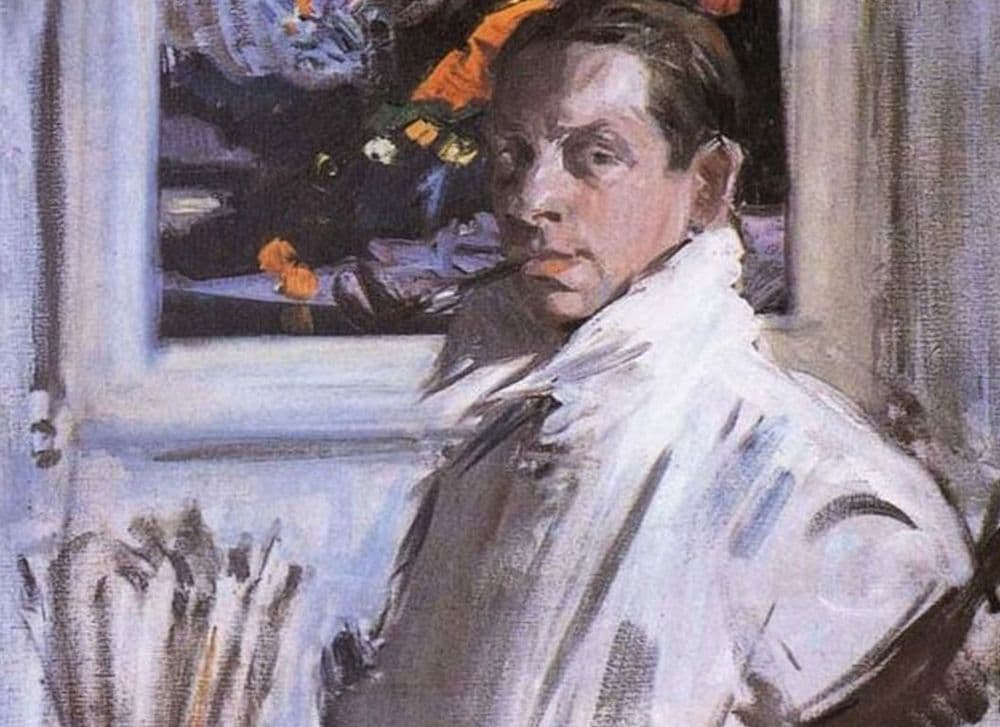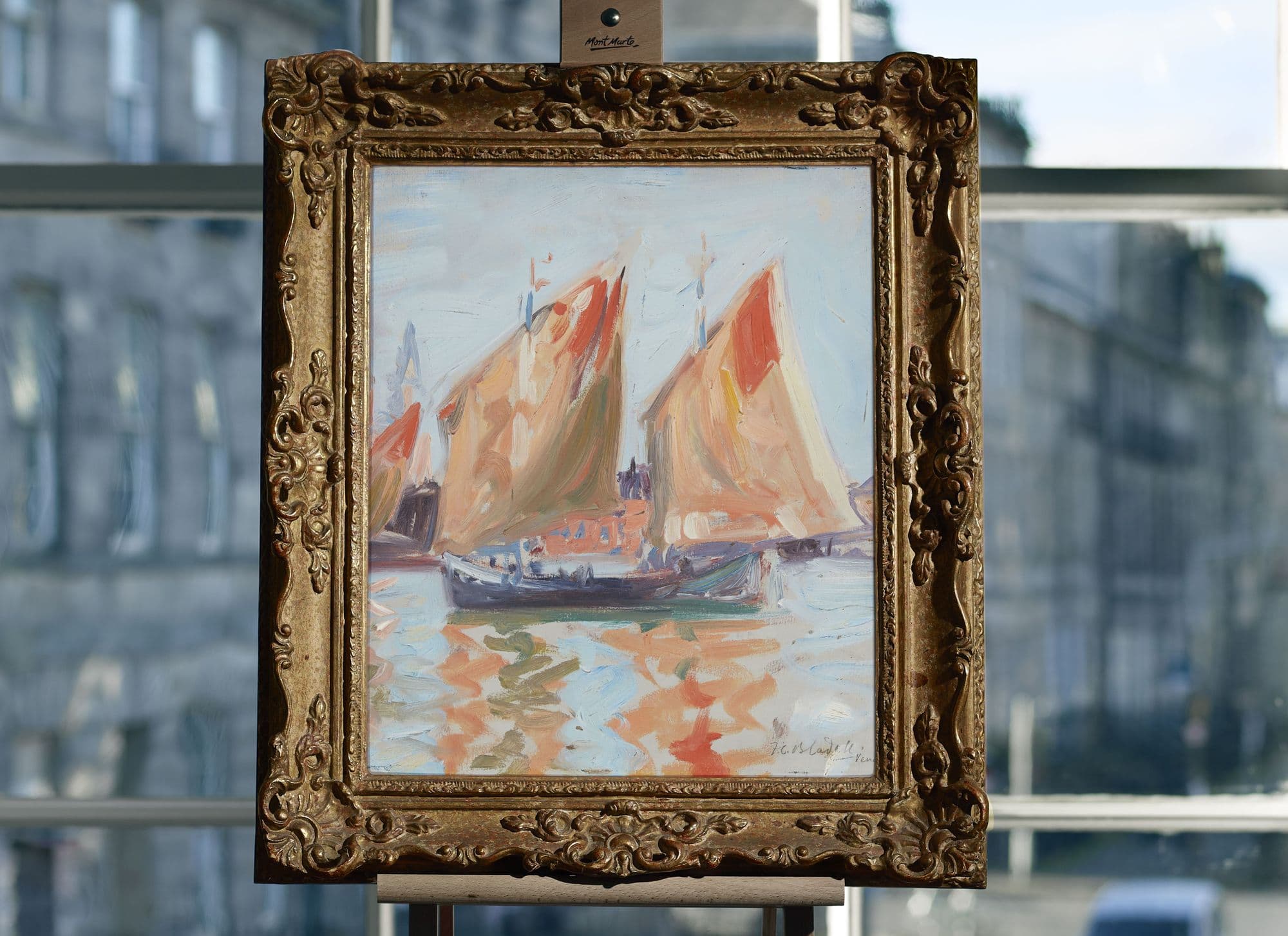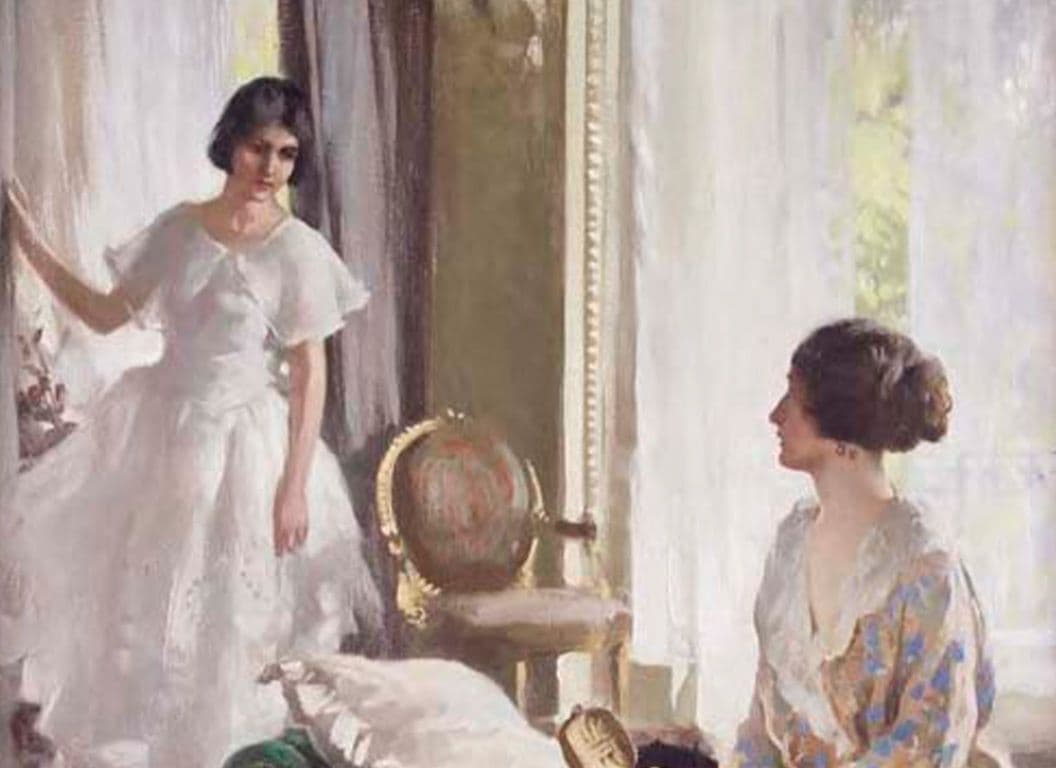Francis Campbell Boileau Cadell RSA, RSW was born in Edinburgh on 12 April 1883 at 4 Buckingham Terrace. He was the first born of Francis Cadell, a surgeon, and his wife Mary Hamilton Boileau. Cadell’s youthful aspiration to attend art school was encouraged by his liberal parents.
After leaving the Edinburgh Academy at the age of sixteen, he moved with his mother and sister to Paris in 1899. In Paris he enrolled at the Académie Julian, a private studio school popular with expatriate students, at which Peploe had previously studied. Cadell returned to Edinburgh in 1902, where he exhibited at the Royal Scottish Academy and Society of Scottish Artists for the first time.
Education & Career
In 1906, Cadell and his family moved briefly to Munich, where he attended the Akademie der bildenden Künste, arriving back in Edinburgh in 1908. He had his first solo exhibition in Edinburgh in 1908, which garnered twenty-five sales including to his school friend and future politician Patrick Ford. The following year, Cadell established a studio in George Street, in the heart of Edinburgh's New Town.
In 1909 Cadell mounted his first solo show in Edinburgh, which was largely unsuccessful. Cadell, however, benefitted from having been well travelled in his youth and he was able to capitalise on family connections, through which he met many of the future patrons who were able to support him through the financial uncertainties of his career. Among such figures was Sir Patrick Ford, who financed a brief but formative sojourn to Venice in 1910.
International Influence
The bright Mediterranean light shimmering off the canals had a marked effect on Cadell's palette, into which he introduced a much more vibrant colour range. Though it is highly unlikely that he saw Monet’s Venetian cityscapes at first hand, the tonal similarities of their work inspired by the city is striking; both artists punctuating the whites and creams of the sun-drenched architecture with pinks, purples and turquoises. Cadell’s technique became looser and more expressive than ever before. Bold, loaded brushstrokes were layered to convey the rippling surface of the waterways and fleeting impressions of passers-by. He revelled in the beautiful scenes by which he found himself surrounded and painted views as varied as that of a bustling St Mark’s Square to quieter, more contemplative corners of the city and its inhabitants.
The results of Cadell's successful and productive trip were exhibited at The Scottish Gallery in Edinburgh in 1912 and proved to be a watershed in his burgeoning career. Ford selected six from the series for his collection, including The Giudecca and Redentore, Venice, which remained in his family for generations. Three further Venetian paintings were presented in Ford's honour to the National Galleries of Scotland in 2014.
Upon his establishment as a working artist in Edinburgh, Cadell successfully distinguished himself as a painter of portraits, figure subjects, still lifes and interior scenes, epitomizing the quiet elegance of Edinburgh’s New Town and appealed to its genteel denizens. As his artistic practice was largely confined to Scotland, Cadell was less responsive to continental developments than the other Colourists; instead he closely focused on studio and interior scenes, experimenting formally with colour and composition. Cadell’s relative artistic isolation and his regular painting trips to Iona have encouraged the perception that he is the most ‘Scottish’ of the Colourists.
Within Cadell’s concentrated focus on still lifes and interior scenes, there is a clear development of style in his oeuvre. In his pre-war paintings, Cadell’s paint handling is marked by a feathery ethereal quality. His early interior scenes also tend towards a restricted, harmonious palette of lilac-tinged whites, rich creams and greys. Works such as Miss Don Wauchope's Robe, painted at Cadell’s studio at 130 George Street, highlight the artist’s interest in the depiction of exquisite objects. The colour tones and focus on the effects of light in elegant interiors, such as Interior - 30 Regent Terrace, is redolent of Turner’s famous interior studies. Many of Cadell’s earlier interior scenes and figure studies share the soft, restricted palette with the portraiture and nocturnes of Whistler and John Singer Sargent.
By the 1920s the languid colouring and fluid handling of Cadell’s earlier works was displaced by an increasing interest in strident colours, a hardening of line and composition, and a flatter painting style marked by a matte facture. In Cadell’s interiors of the period the softness of the pre-war interiors is replaced by a racy Jazz-Age sensibility, the interiors are dominated by a geometric linearity and strong colours compete with an increasing use of flat black. The change in Cadell’s style coincides with his move to a new studio at 6 Ainslie Place, in a Regency town house on the western fringe of Edinburgh’s New Town. Cadell decorated his new premises in a bold colour scheme, influenced by the fashionable Art Deco style.
Iona: An Iconic Inspiration
F.C.B. Cadell had a long-standing love affair with the west-coast isle of Iona and spent many a long Scottish summer painting there alongside fellow Scottish Colourist S.J. Peploe. From about 1912 until at least 1933 Cadell visited the island of Iona virtually every summer, where he produced luminous seascapes and landscapes. Initially, he stayed at the St Columba Hotel, but later he rented various cottages, most frequently Cnoc cùil Phàil, which had views over the Sound of Iona to neighbouring Mull.
Iona had particular attractions for the artist; the ever-changing weather, azure seas and pristine beaches were the perfect subject for the simple lyrical landscapes, which enjoyed commercial success.
Cadell captured the topography and landmarks, the light and the colours as accurately as possible, with surprisingly little artistic licence. He was so accurate that individual rocks can still be matched to photographs of present-day Iona. His amazing accuracy allows us to identify this unusual scene of an approaching storm, taking place over Cathedral Rock, Iona at the north end of the island. In a departure from his usual depictions of the coastline of the island under glorious sunshine, the drama of the approaching weather matches the drama and ruggedness of the rocky coastline and the strength and intensity of crashing Atlantic waves. Still fresh and joyful, the storm brings an unexpected brooding quality to the painting.
Cadell's Iona works proved popular and sold well, not least in the Society of Eight exhibitions. Examples are held in numerous public collections, including those of the National Galleries of Scotland, Aberdeen Art Gallery & Museum, the Hunterian Art Gallery, University of Glasgow and The McManus: Dundee's Art Gallery & Museum.
Later Life
The painting Still Life (The Tulip) and Still Life with Tulips date from the most successful period in Cadell’s career, which began with his arrival at Ainslie Place and ended with his departure in 1931. They show how he used simple still life props as symbols of beauty when creating paintings which are as stunning now as they were when they were created a century ago.
Executed with swift, confident brushstrokes, his technique made the most of the texture and colour of the paper support, sometimes deliberately leaving areas bare as contributions to the overall palette and image. Cadell’s prowess in this medium was recognised by his election to the Royal Society of Scottish Paintings in Watercolour in 1935.
He died of cancer on 6 December 1937 and is buried in Dean Cemetery, Edinburgh.





